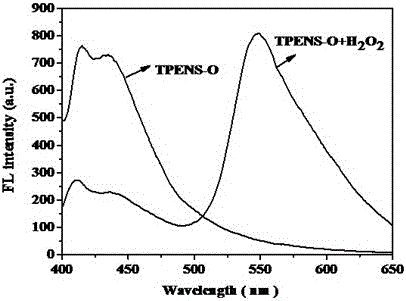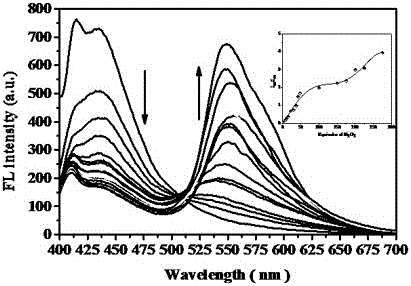Ratio type fluorescent probe for identifying hydrogen peroxide
A fluorescent probe and hydrogen peroxide technology, which is applied in the fields of fluorescence/phosphorescence, material analysis through optical means, luminescent materials, etc., can solve the problem of narrow application range of non-ratio hydrogen peroxide probe
- Summary
- Abstract
- Description
- Claims
- Application Information
AI Technical Summary
Problems solved by technology
Method used
Image
Examples
Embodiment 1
[0025] Synthesis of TPENS-O:
[0026] 0.35g (1mmol) of compound 1, 0.25g (1.1mmol) of 4-bromomethylbenzene borate, 50mg of potassium carbonate, dissolved in 20mL DMF, reacted at room temperature under nitrogen protection for 6 hours, the reaction is over, use mobile phase CH 2 Cl 2 / CH 3 OH=100:1, get TPENS-O through silica gel column.
[0027] 1 H NMR (400 MHz, DMSO- d 6 ) δ 8.11 (d, J = 2.1 Hz, 1H), 8.06 (d, J = 7.9Hz, 1H), 7.97 (d, J = 8.1 Hz, 1H), 7.73 (d, J = 7.7 Hz, 1H), 7.57 (d, J = 7.7Hz, 1H), 7.50 – 7.46 (m, 0H), 7.41 – 7.36 (m, 0H), 7.16 – 7.14 (m, 2H), 7.15– 7.12 (m, 3H), 7.04 (d, J = 1.8 Hz, 1H), 7.01 (d, J = 1.9 Hz, 1H), 6.99 (s, 0H), 5.40 (s, 1H), 1.31 (s, 6H).
Embodiment 2
[0029] The response of TPENS-O to hydrogen peroxide:
[0030] Prepare 1 portion of 10 mL of 10 -3 M Probe of the present invention N , N -Dimethylformamide solution, and then add 5μL to two identical 5mL volumetric flasks, one of which is 50 times the equivalent of the probe by adding hydrogen peroxide equivalent, using PBS / DMF(V:V=1: 1) Dilute the solution to 3mL, and then perform fluorescence detection (λ Ex = 360nm), see the result figure 1 .
[0031] Conclusion: It indicates that the probe is responsive to hydrogen peroxide.
Embodiment 3
[0033] The selectivity of TPENS-O to hydrogen peroxide (see figure 2 ):
[0034] Among them: excitation wavelength is 360 nm; concentration of probe mother liquor: 10 -3 M, the selective ion concentration is 0.1mM. Take 5μL of the probe mother solution to dilute 3ml, and then take 3mL of the above diluent, add various ions for spectral testing, and the concentration of each ion is 0.1mM. The test environment of the probe is PBS / DMF (V:V = 1:1) buffer solution.
[0035] Conclusion: The test results show that the probe TPENS-O has high selectivity to hydrogen peroxide.
PUM
 Login to View More
Login to View More Abstract
Description
Claims
Application Information
 Login to View More
Login to View More - R&D
- Intellectual Property
- Life Sciences
- Materials
- Tech Scout
- Unparalleled Data Quality
- Higher Quality Content
- 60% Fewer Hallucinations
Browse by: Latest US Patents, China's latest patents, Technical Efficacy Thesaurus, Application Domain, Technology Topic, Popular Technical Reports.
© 2025 PatSnap. All rights reserved.Legal|Privacy policy|Modern Slavery Act Transparency Statement|Sitemap|About US| Contact US: help@patsnap.com



